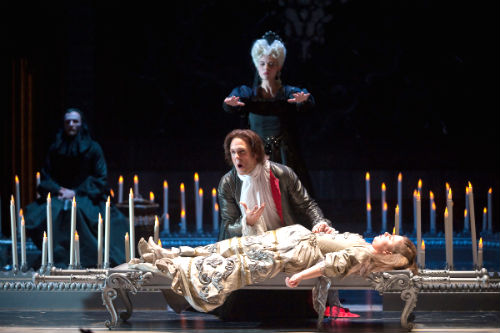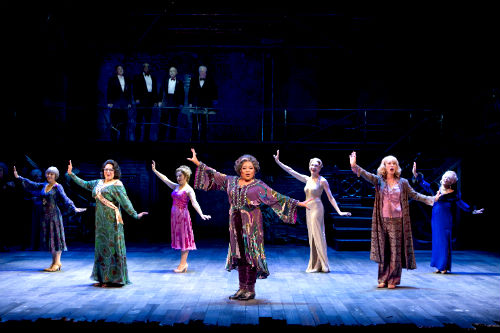BY JAMES JORDEN
Two monochromatic color schemes, two towering box sets, two wardrobes of lavish period costumes, two ensemble casts, two authentic orchestras—even two brightly-colored dream sequences: There are more than a few superficial similarities between two big-scale revivals playing in New York this week: Atys at BAM and Follies at the Marquis Theater on Broadway.
Of course there are also a number of very important differences between the two: the Lully-Quinault tragédie lyrique is almost three centuries the elder of the Sondheim-Goldman musical. Though the current production of Follies is only the second Broadway revival of the 40 year old show, the score and lyrics are endlessly hummable and quotable respectively: everyone knows “Broadway Baby” and “I’m Still Here” and “Losing My Mind” from innumerable great recordings and lousy cabaret acts. The Lully, on the other hand, is still, even more than 20 years since the exhumation of the work by William Christie and Les Arts Florissants, something less than a chart-topper.
But there’s a more subtle difference in these two productions, and it has to do with the working out of concept: that is, coordinating what we hear and (especially) what we see with what is implicit on the page.
The plot of the opera Atys is suggested by an episode in Ovid’s Metamorphoses: the eponymous hero is a follower of the goddess Cybèle and in love with the nymph Sangaride. The goddess takes a fancy to the mortal and for a time he tries to resign himself to a life of service to her cult. When the jealous Cybèle realizes his attraction to Sangaride, she drives him mad so he believes the girl is a wild beast. He murders his beloved and then attempts to commit suicide, but the heartbroken goddess preserves his life by transforming him into an evergreen tree.
The catastrophe in Atys is triggered by just the sort of event that in most operas would signal a happy ending: the two juveniles, each unwillingly committed to a loveless relationship with another, suddenly recognize their love for other. But Atys and Sangaride are not Siegmund and Sieglinde or Raoul and Valentine. No, obviously they are not fated to live together happily ever after (few operatic lovers do) but here there is a strong indication that while their attraction may be natural and innocent, it is their acting on their feelings that is wrong and brings down their downfall.
Even then, the disaster might be averted if Cybèle acted with her head instead of her heart, but even the divine being must learn the hard lesson of self-control. In the world of Atys, everyone has a decreed role to play; trying to step outside these rigid guidelines can easily spell disaster. Thus the virtue to be cultivated is restraint: the ability to recognize one’s feelings but to choose not to act on them if they conflict with one’s duty.
This restraint could hardly have looked very attractive to the work’s first audience, the glittering court of Louis XIV, and how much more so severe and cold must this virtue seem to us in the 21st century.
Here is where the genius of director Jean-Marie Villégier comes in. As Zachary Woolfe pointed out in the New York Times a couple of weeks ago, Villégier’s production team “took a work about restraint and restrained it even further, distilling the story’s different locales into a single room, ornate but somber and lined in black marble.”

The set, then, is a sort of visual oxymoron, a piece of Baroque minimalism. It is lavish, but at the same time, that splendor is kept in tight control. We, the audience, are allowed to see only the one room of what seems to be a splendid suite. Doors at the rear of the chamber open occasionally, allowing glimpses of perhaps even greater beauty, but these vistas have nothing to do with the story at hand. And so, though we long for a longer gaze, we have to learn to content ourselves with what the production is willing to put before us: we are taught, in fact, a lesson in restraint.
Now, that sounds like the production is being didactic or even puritanical, and it’s neither. What makes this engagement with the audience work so smoothly is that what we are allowed to see is so rich and interesting: costumes in black and a multitude of shades of gray, all the way to way to Sangaride’s frock, which is just barely off-white, but in contrast to the very rigid palette sounding it, reads as shell pink at some moments, pale wheat at others. The textures of the costumes range from matte to shiny metallic, and every character sports a wig of fancifully styled snowy tresses.
This visual metaphor of beauty in restraint is further emphasized by the libretto’s two opportunities for visual splendor. The prologue follows the Italian model of the debate among immortals as to the proper subject matter for the impending opera: what theme indeed is worthy of so great a spectator as the magnificent king himself? Here Villégier gently parodies our notions of Baroque visuals by staging this scene as a rehearsal, with the allegorical figures of Time and Nature in pale, faded-looking robes that look like something pulled from wardrobe stock.
The walls of the set are not the severe marble we are to see later, but canvas drops painted with nature scenes. An interpolated figure of the stage manager does his best to block out their movements but is interrupted by a corps de ballet and commedia dell’arte clowns. Finally, as we arrive at the transition from prologue to opera proper, the players scuttle offstage and the canvas plummets to the floor, revealing the “real” set, all the more stark and magnificent in contrast to the frivolous visuals preceding.
Later, most of the third act of Atys is devoted to a dream sequence. The hero, enchanted into a slumber by the goddess, imagines first the pleasures of love, then the dire consequences of defying the will of the gods. Villégier depicts even this state of altered consciousness in a restrained way, simply by introducing costumes of gold and creamy white for dancers and an onstage band of lutes and recorders.
Even the ultimate scene, the transformation of Atys into the immortal fir tree, is underplayed. Cybèle’s henchman Alecton opened a basket and handed out evergreen boughs to the chorus as they processed in a circle around the bier of the dying hero, a purely symbolic act and a formal rite of mourning. The final image was of the goddess herself, deeply moved but permitting herself of no outward show of grief: an apotheosis of restraint.
So this Atys represented precisely what a theatrical concept is supposed to be; as Hal Prince (says in Craig Zadan’s Sondheim & Company:
The whole label that was put on our shows, the whole notion of the “concept” musical, was one that I really resent. I never wished it on myself. It caused a backlash and animosity towards the shows and us . . . It’s called a “unified” show, an “integrated” show.
Sadly, the 2011 revival of Follies represents a giant step backwards from Prince’s aesthetic, especially since his approach to this musical 40 years ago is an object lesson on how a “concept” works.
The show was already drafted as a fairly realistic piece called The Girls Upstairs, about middle-aged ex-chorus girls squabbling at a reunion. Prince organized this material not around the text or the music, but through a single striking visual: a Life magazine photograph of an aged but glamorous Gloria Swanson standing amid the rubble of the demolished Roxy Theatre.
From this image grew the Follies that made Broadway history despite a relatively brief and financially ruinous run: a poetic representation of the impact of the past on the present, played on a skeletal set by Boris Aronson that could evoke both the shattered now and the radiant then of the theater that hosted both the heyday of the Weismann Follies and the poignant last reunion of the “Weismann Girls.”
Prince’s handling of this material, in partnership with Michael Bennett as co-director and choreographer, is so celebrated it hardly needs must retelling: the eerie slow sweep of spectral showgirls, all in white, across the black and gray scaffolding, the miscellany of contemporary clothes indicating the current fortunes of the elderly ex-starlets, the ghost doubles re-enacting the decades-old emotional crises still haunting the central couples, the slow build from drab darkness to a stageful of dancers in blazing red satin—if there is such a thing as a definitive production of a musical, the ur-Follies must be it.
That makes the job of a director approaching a revival difficult: he can’t just slavishly recreate the original, and yet the ghosts, the rubble, the image of the past as a mirror reflection of the present—these are as much Follies as Stephen Sondheim’s music and lyrics or James Goldman’s dialogue. Creating Follies anew wants a genius bordering on recklessness.
This is not a description of Eric Schaeffer, at least not based on the show he delivered first to the Kennedy Center and now to Broadway. In general, it’s respectful—no, make that “reverent”—to the text, or at least to Sondheim’s part. The libretto is heavily cut, based on a version Goldman devised for a Paper Mill Playhouse revival in 1998. The broad outlines of Prince’s visual motifs are also followed, usually quite literally.

Yes, there’s theater rubble on the stage, though it’s very literal, photorealistic rubble, looking more grimly disused than romantically wrecked. Yes, the showgirls lurk in the shadows; yes, the ghost doubles haunt Bernadette Peters and company; yes, there’s even a skimpy red dress for Phyllis’s “Story of Lucy and Jessie” eleven o’clocker.
What seems to be missing, though, is the idea behind the imagery: why are all those scary showgirls hanging around the stage? In Schaeffer’s staging they seem only to be waiting for a cue for the show to start; I wouldn’t be surprised to see one of them light up a cigarette or chew gum.
Or, more to the point, why is this featured actress singing a so-called “Mirror Number” with the leading ladies of the show reduced to backup chorus? Is it a visual metaphor for the coexistence of past and present in the same physical space? Or is it a vehicle for Terri White’s well-preserved vaudeville skills?
Despite terrific singing, generally strong acting, handsome production values—and that rarest of all contemporary Broadway treasures, a full-scale orchestra in the pit playing Jonathan Tunick’s gorgeous orchestrations—there is, alas, no “there” in the 2011 Follies. It’s first-rate entertainment, it’s a rare and precious chance to hear one of Broadway’s greatest scores, it’s even a mostly competent staging of a book show. But a concept musical without a concept is just a musical.
Photos: Stephanie Berger (Atys); Joan Marcus (Follies)
Tags: broadway baby, broadway revival, james jorden, william christie